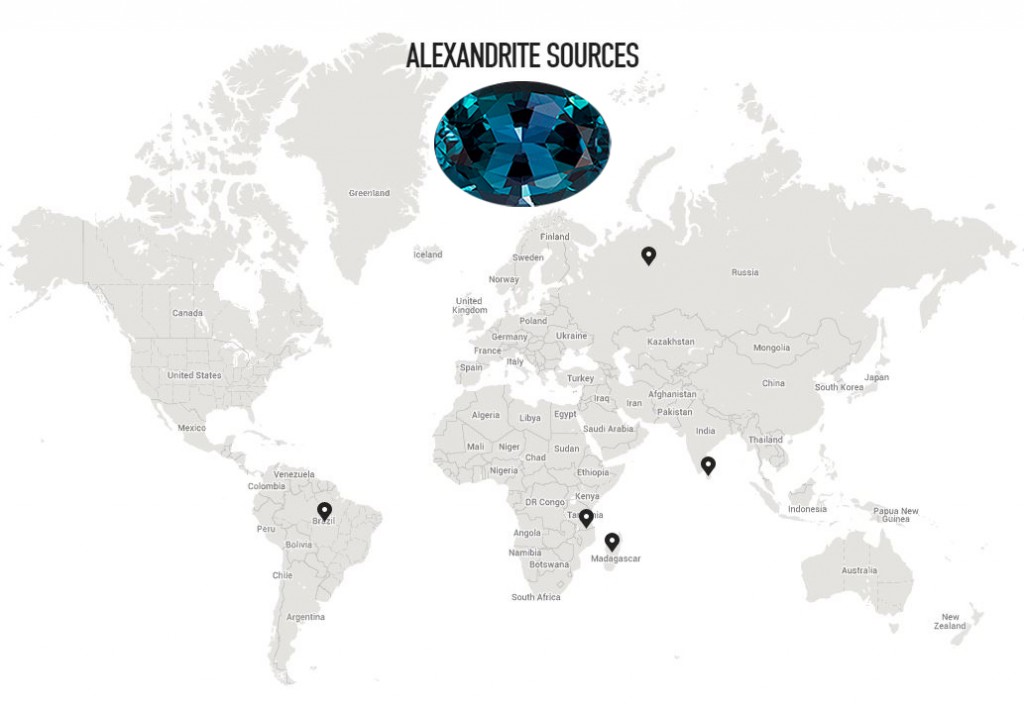Alexandrite is one of several gemstones traditionally coupled to the month of June as it’s birthstone. Alexandrite is a strongly pleochroic gem, which means it can show different colors when viewed from different directions. This gemstone is a very rare variety of the mineral chrysoberyl. Its chameleon-like quality arises from the way this particular mineral absorbs and reflects light. Alexandrite has been cherished throughout history for its extraordinary and mysterious attributes.
Alexandrite’s most desirable color is a green to bluish-green hue in daylight with a strong color change to a red to purplish-red hue in incandescent indoor light. A fine quality gemstone with these saturated color and strong color change is relatively rare. Most natural alexandrite found today will be yellowish-green in daylight and change to a brownish-red in incandescent light. The gemstone owes its intense color change ability to the mineral’s unusual light-absorbing properties, and the presence of chromium in its crystal structure. Alexandrite’s dramatic green to red color change is sometimes described as “emerald by day, ruby by night.”
Listed below are the locations where alexandrite naturally occurs and is mined to be transformed into beautifully faceted gemstones.
- Brazil – A relatively new mining location for the rare gemstone, Brazil became an important new alexandrite source in the late 1980s and early 1990s.
- Tanzania – Gem miners in Tanzania find alexandrites, sapphires, and occasionally diamonds on the banks of the Muhuwesi River, near Tunduru.
- Madagascar – Alexandrite rough mined in Madagascar often displays intense color and color change.
- Sri Lanka – Sri Lanka is home to a wide variety of colored stones, but alexandrite is one of the most desirable gems to be mined in this location.
- Russia – Large alexandrite deposits were first discovered in Russia’s Ural Mountains in 1830. Russia is considered the most traditional source of the gemstone. The first alexandrites found in those deposits were of fine quality with intense hues and extreme color change. The gem was named for the young Alexander II, heir to the throne when the discovery was made. These mines did not last forever, and we must now rely on other sources for alexandrite. Though some claim that there will never be as fine of quality as the first gems found in Russia.
If you are lucky enough to hold the very rare and extremely attractive alexandrite as your birthstone, let us at Knox Jewelers help you custom create a one-of-a-kind piece to showcase this beautiful vibrant color-changing gemstone. Fine alexandrite is available, but extremely rare. To remedy this, several labs in present day can produce lab-grown stones with the same chemical and physical properties as natural alexandrite. If a you have any questions regarding lab created alexandrite, we would be more than happy to assist. Any custom piece of jewelry could be tailored to incorporate this remarkable birthstone. The possibility are endless with such a curious and colorful mineral. A Knox Jewelers custom created piece, featuring a beautiful alexandrite is the perfect way to celebrate any occasion falling within the month. Contact us today and let’s get started. We can always search our cutters’ inventory for your perfect gemstone, or we have a selection of alexandrites already available just waiting to be transformed!

